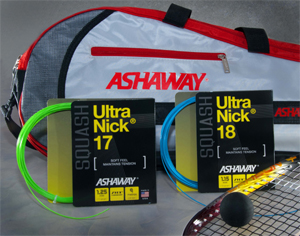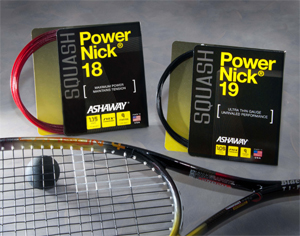|
|

Zyex® String Construction: Hard and Soft Power
By Steve Crandall
Vice President, Sales & Marketing
Ashaway Racket Strings
Last time in this column we compared the material properties of natural gut, nylon and ZyexZyex®, and how relative factors such as dynamic stiffness, tension holding ability, abrasion resistance, and cost affect string performance and choice. But there is another whole side to the question of string performance, and that has to do with core construction. We've talked about this a number of times in the past, but as with many Zyex-related issues, things have changed as this material has improved.
 |
 |
| PowerNick's "hard power" characteristics are achieved by the formulation of the Zyex material and the core construction, which is composed of a single large monofilament surrounded by a number of slightly thinner monofilaments, called "multi-stranded monofilament." Ashaway's UltraNick in contrast uses a more traditional multifilament core and is designed to give and stretch a bit before rebounding - making for a "softer" feel. |
Back in the 1940s, when DuPont first introduced nylon for use in racquet strings, there was only monofilament because that's all they knew how to make. Monofilament construction provided good power and durability, but it was not very flexible. This made it more difficult to string a racquet, and made the string bed stiffer and less responsive.
So today we primarily use multifilament construction. Multifilament cores are made from hundreds - or even thousands - of very thin strands or fibers, twisted together and bound by a twisted or braided jacket. This produces a core with a softer, more resilient feel and better elasticity. Strung at relatively high tension to maximize control, multifilament cores generate good power, and even though they are more expensive to produce and not quite as durable as monofilament strings, they still represent an overall improvement in performance.
Now enter Zyex. Originally developed for racquet strings about 25 years ago, both the formulation and production processes of the material have been continually improved in the years since, until the Zyex of today is really a different kind of animal: different from any other string material, and even different from the original Zyex. These advances have resulted in Zyex filaments that are even finer and stronger than before. This, in turn, has allowed us to significantly increase the range of performance characteristics we can offer in a string, and to produce thinner, stronger, lighter-weight strings that provide superior feel, more power, and improved ball control. It has even allowed us to construct an entirely new kind of core.
While our UltraNickZyex® line uses the more traditional multifilament core construction, PowerNickZyex® utilizes what we call a "multi-stranded monofilament" core. As the name implies, this consists of a single, larger monofilament, surrounded by a number of slightly thinner monofilaments, all encapsulated with a high tenacity monofilament nylon wear surface that is textured to provide optimum ball response and spin characteristics.
Think of multi-stranded monofilament construction as a morphing of mono- and multifilament construction: it combines the power and durability of monofilaments with the flexibility and elasticity of multifilament construction. It has also allowed us to produce the thinnest squash string ever made, PowerNick 19.
We like to differentiate between these two types of core construction - and between the UltraNick and PowerNick lines - by the terms "soft" and "hard" power. By "hard power" we mean crispness, or pop, that sensation you get with PowerNick of the ball leaping off the racquet the instant it strikes. UltraNick, on the other hand, will give and stretch a bit before rebounding - making for a "softer" feel. PowerNick strings are stiffer and rebound faster, driving the ball.
The soft power of UltraNick strings appeals primarily to two groups. One is top competitive players who find that softer strings increase 'bite' on the ball, and give them better overall control and an ability to 'cut' the ball and increase spin. The other group is the increasingly savvy recreational set. These are players who don't necessarily have the skill or power of the pros, nor the conditioning to allow their bodies to shrug off the rigors of the game. They, too, are looking for an extra edge, but they also want a string that plays softer and is more forgiving to tender joints and muscles.
On the other hand, many top touring pros like the hard power of PowerNick. David Palmer, for example, has been using PowerNick 19 since it first came out. Known as a 'flat hitter,' he says the string gives him the power to play hard and fast, but also provides nice touch and control at the front of the court. On the other hand, Gilly Lane, who is currently ranked #2 in the US, uses PowerNick 18. He also claims the string gives him the best touch and control. But Gilly uses more of a cut stroke, and needs the added durability of PowerNick 18 because he strikes the ball differently than Palmer.
This article previously appeared in Squash Magazine.
|